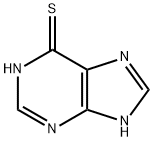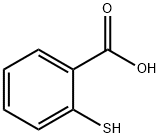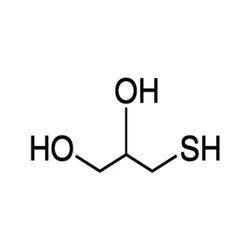3-Mercapto-1,2-propanediol
Synonym(s):α-Monothioglycerol;α-Thioglycerol;1-Thioglycerol;3-Mercapto-1,2-propanediol
- CAS NO.:96-27-5
- Empirical Formula: C3H8O2S
- Molecular Weight: 108.16
- MDL number: MFCD00004879
- EINECS: 202-495-0
- SAFETY DATA SHEET (SDS)
- Update Date: 2025-12-17 09:49:52

What is 3-Mercapto-1,2-propanediol?
Description
1-Thioglycerol is a reagent used in fluorescence, spectroscopy, and microbiology techniques. Varying the concentration of 1-thioglycerol in the preparation of CdSe/CdS core-shell ultrasmall quantum dots (CS-USQDs) allows a precise way to control the size of the shell, with shell size increasing with increased concentration. It is used as a capping agent in the synthesis of nanocrystals analyzed via Raman and UV/Vis spectroscopy. Biologically, 1-thioglycerol stimulates porphyrin synthesis and increases glutamyl-tRNA reductase activity in E. coli grown in an aerobic environment. It was previously a component in hair permanents used to produce waves or curls.
Chemical properties
clear colorless to yellowish viscous solution
Chemical properties
Monothioglycerol occurs as a colorless or pale-yellow colored, viscous, hygroscopic liquid with a slight odor of sulfide.
The Uses of 3-Mercapto-1,2-propanediol
3-Mercapto-1,2-propanediol has been used in a study to assess the manipulation of aqueous growth of CdTe nanocrystals. It has also been used in a study that investigated the effect of surface attachment on ligand binding
The Uses of 3-Mercapto-1,2-propanediol
3-Mercapto-1,2-propanediol can be used as antioxidant preservative; reagent in analytical chemistry, cell culture research. Matrix substrate in fast atom bombardment mass spectrometry.
The Uses of 3-Mercapto-1,2-propanediol
It generally used as a size-regulating capping agent for nanocrystals. 1-Thioglycerol is also used in bacteriology experiments to induce the synthesis of porphyrin compounds in aerobically growing Escherichia coli. Also used to study the pH-sensitive photoluminescence of aqueous thiol-capped CdTe nanocrystals. 1-Thioglycerol is used to develop and test thiol functionalized copolymers. 1-Thioglycerol is used as a post-modification agent in the generation of non-standard peptide foldamers.Potential substitute for 2-mercaptoethanol, probe for the study of lymphocyte activation.
What are the applications of Application
1-Thioglycerol is a chemical known to stimulate the synthesis of porphyrins in aerobic Escherichia coli.
Definition
ChEBI: A thiol that is glycerol in which one of the primary hydroxy groups is replaced by a thiol group.
Production Methods
Monothioglycerol is prepared by heating an ethanolic solution of 3- chloro-1,2-propanediol with potassium bisulfide.
General Description
1-Thioglycerol stimulates the synthesis of porphyrin in aerobically growing Escherichia coli. It is an inhibitor of glycerol kinase activity in vitro and in situ.
Pharmaceutical Applications
Monothioglycerol is used as an antioxidant in pharmaceutical
formulations, mainly in parenteral preparations.Monothioglycerol
is reported to have some antimicrobial activity.It is also
widely used in cosmetic formulations such as depilating agents.
Therapeutically, monothioglycerol has been used in a 0.02%
w/w aqueous solution to stimulate wound healing, and as a 0.1%
w/w jelly in atrophic rhinitis.
Safety Profile
Poison by intraperitoneal and intravenous routes. Experimental reproductive effects. Mutation data reported. Flammable when exposed to heat or flame; can react with oxidizing materials. When heated to decomposition it emits hghly toxic fumes of SOx.
Safety
Monothioglycerol is generally regarded as a relatively nontoxic and
nonirritant material at the concentrations used as a pharmaceutical
excipient. It is used in topical and injectable preparations.
Undiluted monothioglycerol is considered a poison by the IP and
IV routes; it has also been reported to be mutagenic.
LD50 (cat, IV): 0.22 g/kg
LD50 (mouse, IP): 0.34 g/kg
LD50 (rabbit, IV): 0.25 g/kg
LD50 (rat, IP): 0.39 g/kg
Storage
Monothioglycerol is unstable in alkaline solutions. Monothioglycerol should be stored in a well-closed container in a cool, dry place.
Incompatibilities
Monothioglycerol can react with oxidizing materials.
Regulatory Status
Included in the FDA Inactive Ingredients Database (IM, IV and other injections). Included in the Canadian List of Acceptable Nonmedicinal Ingredients.
Properties of 3-Mercapto-1,2-propanediol
| Melting point: | <25 °C |
| Boiling point: | 118 °C5 mm Hg(lit.) |
| Density | 1.25 g/mL at 25 °C(lit.) |
| vapor pressure | <1 hPa (20 °C) |
| refractive index | n |
| Flash point: | >230 °F |
| storage temp. | 2-8°C |
| solubility | absolute ethanol: 1 mL/mL |
| form | liquid |
| pka | pK1:9.43 (25°C,μ=0.5) |
| color | Clear colorless to yellow |
| PH | 3.5-7.0 |
| Odor | Stench odour |
| Water Solubility | slightly soluble |
| Sensitive | Air Sensitive & Hygroscopic |
| Merck | 14,9335 |
| BRN | 1732046 |
| Stability: | Air Sensitive, Hygroscopic |
| CAS DataBase Reference | 96-27-5(CAS DataBase Reference) |
| NIST Chemistry Reference | Monothioglycerol(96-27-5) |
| EPA Substance Registry System | 1,2-Propanediol, 3-mercapto- (96-27-5) |
Safety information for 3-Mercapto-1,2-propanediol
| Signal word | Danger |
| Pictogram(s) |
 Skull and Crossbones Acute Toxicity GHS06 |
| GHS Hazard Statements |
H302:Acute toxicity,oral H311:Acute toxicity,dermal H315:Skin corrosion/irritation H317:Sensitisation, Skin |
| Precautionary Statement Codes |
P280:Wear protective gloves/protective clothing/eye protection/face protection. |
Computed Descriptors for 3-Mercapto-1,2-propanediol
| InChIKey | PJUIMOJAAPLTRJ-UHFFFAOYSA-N |
3-Mercapto-1,2-propanediol manufacturer
New Products
4,4-Difluoropiperidine hydrochloride tert-butyl 9-methoxy-3-azaspiro[5.5]undecane-3-carboxylate Indole Methyl Resin N-Isopropylurea N,N-Dicyclohexylcarbodiimide(DCC) MELDRUMS ACID 5-METHYLISOXAZOLE-4-CARBOXYLIC ACID Magnessium Bis glycinate Zinc ascorbate 1-bromo-2-butyne 2-acetamidophenol 9(10H)-anthracenone Erythrosin B, 4-Piperidinopiperidine 2-((4-morpholinophenylamino) (methylthio) methylene) malononitrile 2,4-dihydroxybenzaldehyde 3-(4-morpholinophenylamino)-5-amino-1H-pyrazole-4-carbonitrile Methyl 2-methylquinoline-6-carboxylate 2,6-dichloro-4-nitropyridine 4-Bromo-2-chlorobenzonitrile 2-(benzylamino)acetic acid hydrochloride 4-(tert-Butoxycarbonylamino)but- 2-ynoic acid 3,4-dihydro-2H-benzo[b][1,4]dioxepine 1-Phenyl-1-cycloprppanecarboxylicacidRelated products of tetrahydrofuran








You may like
-
 3-Mercapto-1,2-propanediol CAS 96-27-5View Details
3-Mercapto-1,2-propanediol CAS 96-27-5View Details
96-27-5 -
 1-Thioglycerol CAS 96-27-5View Details
1-Thioglycerol CAS 96-27-5View Details
96-27-5 -
 Monothioglycerol, 90% CAS 96-27-5View Details
Monothioglycerol, 90% CAS 96-27-5View Details
96-27-5 -
 Monothioglycerol CASView Details
Monothioglycerol CASView Details -
![1-Thioglycerol [Matrix for FABMS and liquid SIMS] CAS 96-27-5](https://img.chemicalbook.in//Content/image/CP5.jpg) 1-Thioglycerol [Matrix for FABMS and liquid SIMS] CAS 96-27-5View Details
1-Thioglycerol [Matrix for FABMS and liquid SIMS] CAS 96-27-5View Details
96-27-5 -
 1-THIOGLYCEROL AR CAS 96-27-5View Details
1-THIOGLYCEROL AR CAS 96-27-5View Details
96-27-5 -
 Monothioglycerol (CAS Number: 96-27-5)View Details
Monothioglycerol (CAS Number: 96-27-5)View Details
96-27-5 -
 1-Thioglycerol (CAS Number: 96-27-5)View Details
1-Thioglycerol (CAS Number: 96-27-5)View Details
96-27-5
